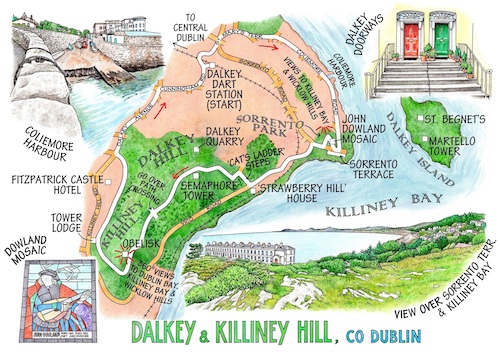A walk with Pat Liddy is the best way in the world to get to know Dublin from the inside out.
And if you can’t secure the company of Pat, complete with large black fedora and 1,001 stories, then his book Walking Dublin is a pretty good substitute – erudite, chatty and a thoroughly entertaining guide, like the man himself.

I’d earmarked his Dalkey and Killiney Hill ramble for a slack morning one fine day, and when the right weather came along – cold, windy and clear to the skyline – I disembarked at Dalkey’s DART station muffled up, Liddy in hand, heading for the heights. Dalkey has somehow held onto its air of a small seaside town, in spite of the tiger mansions pressing in from the hills with their plate glass, cupolas and fierce guardian gates.
Out along the coast road Coliemore Harbour slumbered, the slap of glass-green waves on its granite slipway the loudest sound. Across the water on Dalkey Island the grey stone Martello tower stood out against a pale sky with fiery streaks low to the horizon and the ruins of St Begnet’s Church half-invisible against the green and grey rocks. A little group of black guillemots with distinctive white wing patches bobbed off the pier, and a flight of brent geese went hurrying south, their dark wings a blur against the water.
In tiny Sorrento Park I found a memorial mosaic to Elizabethan composer John Dowland ‘whose heavenly touch upon the lute doth ravish human sense.’ The portrait had been defaced, literally – the great man’s face had been crudely bashed off by some selfish ignoramus. But Dowland’s slender ceramic hands still plucked at his lute. From the summit of the park I surveyed the Irish Bay of Naples from the summit of the park – out over the Victorian perfection of Sorrento Terrace in its colour wash of strawberry, peach and lemon, round Killiney Bay with fantasy villas piled on the wooded hillside above the grey ribbon of the Vico Road, the Wicklow Hills hidden and revealed by drifting cloud, the Sugarloaves peaked and sharp, and down on the coast the round knobbly lump of Bray Head.
Halfway up the Vico Road I took to the Cat’s Ladder, a concertina of steps climbing the hillside; then on up a dusty walled laneway to the old signal tower on Dalkey Hill. A clink of pitons far below betrayed the presence of young rock climbers tackling the all-but-sheer walls of Dalkey granite quarry. Their orange-helmeted heads inched upwards, and the reassuring cries of the instructors came echoing up. ‘Come on, there, Siobhan – easy now… that’s it, across with the left foot … no, the other one, Siobhan!’
The path dipped downhill past a grove of Scots pine, then rose from a saddle of lower ground by steps and stony sections through a mossy woodland to the obelisk on Killiney Hill. Here was the full 360o view – the Wicklow Mountains a sea of peaks in the south, and northwards the city laid out in a many-coloured sprawl around Dublin Bay, from the praying-mantis arms of Dun Laoghaire harbour to the miniature Gibraltar of the Howth peninsula.
I sat in one of the obelisk alcoves, admiring the prospect of Wicklow and chatting to a lady with a dog. ‘A rescue dog,’ she said, ‘he was fished out of the canal, tied up to drown in a plastic bag.’ Yet with the application of a little loving care, said its companion, the dog was now as trusting and friendly as could be. So there’s hope for us all.
WAY TO GO
MAP: OS of Ireland 1:50,000 Discovery 50; detailed map/instructions in Walking Dublin by Pat Liddy (see below).
TRAVEL: DART or Bus 8 to Dalkey; M50 Jct 14-16.
WALK DIRECTIONS: From Dalkey DART station, follow St Mary’s Terrace to cross 5-way junction. St Mary’s Terrace bends right into Coliemore Road (‘Coast Road’). On past Coliemore Harbour. On sharp right bend by Sorrento Terrace, right into Sorrento Park; path to summit viewpoint. Down to leave park below bandstand. Right to junction, left up Vico Road. In 500m, by Gothic ‘Strawberry Hill’ house on left, cross road; up ‘Cat’s Ladder’ steps. At top, left for 30m; by ‘Mount Henry’, right up narrow laneway to signal station on Dalkey Hill. On past aircraft beacon, down with wall and pine grove on right. Across path crossing; on up to obelisk on Killiney Hill. Down path with sea on left; follow it past Tower Lodge, car park and playground to Killiney Hill Road. Right; pass The Metals crossing; right along Cunningham Road. At bottom, left to Dalkey DART station.
LENGTH: 6.75 km/4 miles – allow 2 hours or more
GRADE: Moderate
CONDITIONS: Pavements, tracks, paths. Plenty of steps!
DON’T MISS:
colourful fishing boats in Dalkey Harbour, and view to Dalkey Island
Sorrento Park’s mosaic of John Dowland, and the view over Killiney Bay
View from obelisk on Killiney Hill over the Wicklow Hills and Dublin Bay.
REFRESHMENTS: Picnic at the obelisk on Killiney Hill
ACCOMMODATION: Fitzpatrick’s Castle Hotel, Dalkey (01-230-5400, www.fitzpatrickcastle.com) – a splendid, opulent hotel, friendly and helpful too. From 89 euros dble B&B
GUIDEBOOK: Walking Dublin by Pat Liddy (New Holland) – one of 24 great walks in and around the capital, by expert Pat (01-832-9406; 087-905-2480; www.walkingtours.ie)
WALKING in IRELAND: Walking tour operators, local walks including Discover Ireland’s National Loop Walks, walking festivals throughout Ireland: www.discoverireland.ie/walking.
BOOK: Christopher’s book Walking in Ireland (Ebury Press) contains 50 of his favourite Irish Independent walks.
TIC: Dalkey Castle, Castle Street (01-285-8366)